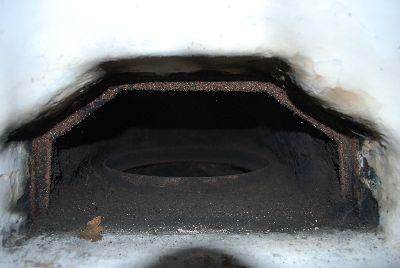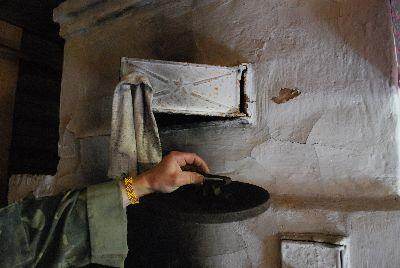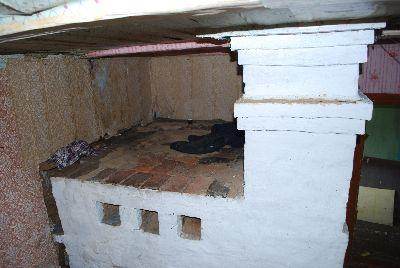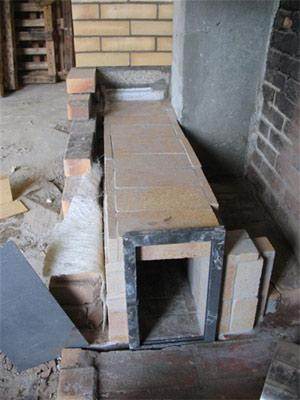




Is there anything that can explain the performance, or practical use of the dual exit flue area? Does this dual exit flue have beneficial/practical use because of variable outdoor wind, or during cold start-ups?... or maybe this is just the way your lab testing apparatus is setup.






God of procrastination https://www.youtube.com/watch?v=q1EoT9sedqY




Peace, Jim
 1
1




paul wheaton wrote:
The lever you see is connected to a baffle inside the duct designed to direct the exhaust either through the roof or through the wall. When you route through the roof, the stove pipe collects radiant heat from the barrel and then the vertical pipe will pull exhaust as well as the heat riser pushing. Unfortunately, when we flip the lever, the pull in the stove pipe is so strong that the exhaust is still pulled up - so the baffle is probably blocking only 95%.
 If you are trying to make something that will pass permit... the last 20% is something you will have to deal with one way or the other. The most obvious thing of course in a sealed system like the RMH is to seal the intake 100% which is safer anyway from idiots.
If you are trying to make something that will pass permit... the last 20% is something you will have to deal with one way or the other. The most obvious thing of course in a sealed system like the RMH is to seal the intake 100% which is safer anyway from idiots.
819) When it gets really cold, the vertical stove pipe pulls really hard 24x7. So you get a really rockety burn when you are burning. And when you are not burning, then all of the room air is pulled through the system, warmed by the mass and your mass warmth is pulled outside.
820) Ernie, Erica and I all agree that air intake MUST come from down low - to avoid creating anything resembling a competing chimney. And, when it gets really cold outside, the uninsulated vertical air intake starts to act like a push to the system as the intake is warmed by room temp air. So the air intake itself seriously cools the room with this heat exchange. And then pushes really cold air into the rmh which then starts to cool the whole mass.
821) We need to insulate the air intake.
822) We need a way to completely shut off the air intake outside.
823) We need the ability to completely shut off the vertical stove pipe at the roof.





Peace, Jim




Jim LaFrom wrote:Do I dare ask you to post the first 818 observations on the pebble stove?





Blocking the air intake 100% should fix that.
I think the intake is square and so a wood or metal square that is bigger than the intake with a square of rockwool attached that just fits might work well.
The heater is not the only thing that needs fresh air, the people do to.
I would say Never. It would be ok for keeping the home warm while all occupants are outside... but remember the stupid factor when someone decides to leave it closed "cause its a little warmer".




Iterations are fine, we don't have to be perfect
My 2nd Location:Florida HardinessZone:10 AHS:10 GDD:8500 Rainfall:2in/mth winter, 8in/mth summer, Soil:Sand pH8 Flat
 3
3








 Hope it furthers the empire.
Hope it furthers the empire.
Peace, Jim




 1
1




Peace, Jim




Unfortunately, when we flip the lever, the pull in the stove pipe is so strong that the exhaust is still pulled up - so the baffle is probably blocking only 95%.
The problem with this particular exhaust through the wall is that it has two extra 90 degree turns. So it isn't a very fair comparison.

 1
1




Hans Albert Quistorff, LMT projects on permies Hans Massage Qberry Farm magnet therapy gmail hquistorff
 1
1




paul wheaton wrote:
So maybe just mount some sort of manual plug outside?













Maybe some pictures will help. All of these are from this page:
A story about an abandoned village. (Quite interesting in it's own right)
Permaculture is a gestalt ... a study of the whole. Not just how to produce more and better food, but how human life on the planet affects and is affected by the surrounding environment.
Bill Kearns




Jim LaFrom wrote:Paul,
Again referring to #822.
I'm surprised you are trying this. Erica had made reference to this wood stove site in an older video of hers (or maybe post) and "The Myth" of using an outdoor air source. Maybe the stove is trying to tell you something. Granted this is all just an experiment but this is one more thing to check off the list
http://woodheat.org/outdoor-air-supplies.html




Len Ovens wrote:
This first one is open but shows the inside quite well:
You can see the flue sticking up from the bottom. The chimney continues overhead. (brick)
The next one shows the cap and the outside door (not from the same heater though)




At this point in time I am thinking that the direction I want to move toward is to have a system that has lots of control - something where I can turn things on and off as needed. I like the idea of having some draw when starting the fire. I like the idea that if I start to get some smoke back I can adjust things to be a little rocketier. If the system is too rockety (and a lot of heat is escaping outside) I can slow things down a bit.
And, of course, this particular heater has the primary function of solving some of the problems we've had in the rocket mass heater world.
Erica and I have talked about some ideas with putting heat sink fins on the duct work in the gravel to make sure we extract more heat before it goes out the wall. We've also talked about ideas on sealing the duct without gluey-tape.
Peace, Jim








Don't we all!paul wheaton wrote:If it is a really cold day outside, I wand to adjust things to be less rockety.
If it is a cool day outside (55 degrees) I want to adjust things to be more rockety.
There are things that can be controlled. I want to control them.
paul wheaton wrote:
I prefer to have air pulled out of the room instead of having air pulled from outside. Most of the time. For that 10% of the time I want air to be pulled from outside, I want the option.
When the fire is out - i want to make sure that the air moving through the system is at a FULL STOP.
If the exhaust is leaving at 140 degrees, I want to fix that.
I do not need perfect. But I do want better.
 )
)Peace, Jim




There is something called Physics and we can't fight that.
If you pull air out of a room there is something is that is going to replace it . In HVAC terms this is called makeup air. (cool air?) You will either depressurize the room if it were totally airtight or air will find it's own way in. Nature abhors a vacuum. (Permaculture principle )









paul wheaton wrote:
Which is entirely the point. I prefer to have the stale, stinky air removed from the room and replaced with fresh air from outside. Yes, the air from outside will be cold - and it is coming in while my rocket mass heater is running.
God of procrastination https://www.youtube.com/watch?v=q1EoT9sedqY





paul wheaton wrote:If it is a really cold day outside, I wand to adjust things to be less rockety.
If it is a cool day outside (55 degrees) I want to adjust things to be more rockety.
There are things that can be controlled. I want to control them.
paul wheaton wrote:
I prefer to have air pulled out of the room instead of having air pulled from outside. Most of the time. For that 10% of the time I want air to be pulled from outside, I want the option.
When the fire is out - i want to make sure that the air moving through the system is at a FULL STOP.
If the exhaust is leaving at 140 degrees, I want to fix that.
I do not need perfect. But I do want better.
Jim LaFrom wrote:
There is something called Physics and we can't fight that. If you pull air out of a room there is something is that is going to replace it . In HVAC terms this is called makeup air. (cool air?) You will either depressurize the room if it were totally airtight or air will find it's own way in. Nature abhors a vacuum. (Permaculture principle)
 ) recombine with the outside air at lower than room temperature. Still within what physics will allow of course. I think this is possible, at least in really cold weather, shoulder seasons may be more difficult. I am not sure the flue gas will be less than room temp when it exits the house itself, but the gas should be cooled in such a way the heat can be of use in any case. (such as warming up incoming air)
) recombine with the outside air at lower than room temperature. Still within what physics will allow of course. I think this is possible, at least in really cold weather, shoulder seasons may be more difficult. I am not sure the flue gas will be less than room temp when it exits the house itself, but the gas should be cooled in such a way the heat can be of use in any case. (such as warming up incoming air)










Len Ovens wrote:Wow I can answer two posts in one

paul wheaton wrote:If it is a really cold day outside, I wand to adjust things to be less rockety.
If it is a cool day outside (55 degrees) I want to adjust things to be more rockety.
There are things that can be controlled. I want to control them.
practice, just over)
paul wheaton wrote:
I prefer to have air pulled out of the room instead of having air pulled from outside. Most of the time. For that 10% of the time I want air to be pulled from outside, I want the option.
When the fire is out - i want to make sure that the air moving through the system is at a FULL STOP.
If the exhaust is leaving at 140 degrees, I want to fix that.
I do not need perfect. But I do want better.
sealing the system at fire out is just good sense. As you can tell by my pics above this is not a new idea.
Jim LaFrom wrote:
There is something called Physics and we can't fight that. If you pull air out of a room there is something is that is going to replace it . In HVAC terms this is called makeup air. (cool air?) You will either depressurize the room if it were totally airtight or air will find it's own way in. Nature abhors a vacuum. (Permaculture principle)
Yes, but we want the air to come in under the best conditions that physics allows. We want to make the best use of that air. We already know we will have air coming into the room aside from any direct feed. We don't want a sick house after all. I can't really speak for Paul, but my Goal would be to have as much fresh air entering the home as I can without it affecting the comfort of the home or removing all our heat either. I also wish to stay away from any active system outside the effects of the burn itself. This means being very careful in design of the living space and the air entrance. The living space should be set up so as not to have people in the way of any cool draft created and have the fresh air enter the dwelling in such a way that it travels some distance through something warm before it can be felt. It is not just designing a heating system that works well, but designing the home around that as well. In this case, Paul is setting aside some of the home design elements (not ignoring, but not studying just now) and finding out what the heater itself needs to work best. Then the home can be designed around those parameters.
That is why In my earlier post I suggested bringing in the make up air under the mass storage where it would be warmed by heat that otherwise would take a long time to reach the room. Then it would be comfortable and healthy for people and the fire to breath before it exits again. When the fire path is blocked there will still be air exiting through unsealed portions of the building, the make up air for that can continue to be heated by the mass before entering the room.
Hans Albert Quistorff, LMT projects on permies Hans Massage Qberry Farm magnet therapy gmail hquistorff








Allen Herod wrote:Maybe this has been tried. Forgive me, I haven't read all the RMH stuff but here's my brainstorm (possibly a brain fart). I saw some discussion on the intake coming from inside or outside. I'm on the bandwagon that it needs to come from inside for healthy air exchange. Now for my brain fart... What about an exhaust recirculation back into the burn chamber, much like a turbo charger on a diesel engine? On a turbo diesel engine (I believe this is the concept) fresh air is pulled in but exaust is also forced back into the intake (via the turbo, driven by exhaust pressure) creating more fresh air draw (kind of like a siphon effect) but also recirculating heat that would otherwise be lost out the chimney. Maybe it has been tried and failed or is already part of the system and im missing it. Seems like a possibility to me and should boost the initial heating up of the system at the very least? It would possibly increase air exchange in the room but also generate more heat in return. Point me in the right direction if I am missing something.

Peace, Jim












paul wheaton wrote:My brother and I had a few chats. he has ordered the steel to make two guillotine style shutoffs. One for the stove pipe going to the roof and one for the air intake.
He wanted to make one for the wall exhaust also - but I said lets let that one come a week or two later. Because we might learn some things about the first two and want the third to be slightly different.
Another thing that came up today. We seem to have just heaps of winter projects.
Peace, Jim





 1
1




paul wheaton wrote:I really wish I could have said "activate maximum rockety!"
God of procrastination https://www.youtube.com/watch?v=q1EoT9sedqY




Jim LaFrom wrote:
Allen Herod wrote:Maybe this has been tried. Forgive me, I haven't read all the RMH stuff but here's my brainstorm (possibly a brain fart). I saw some discussion on the intake coming from inside or outside. I'm on the bandwagon that it needs to come from inside for healthy air exchange. Now for my brain fart... What about an exhaust recirculation back into the burn chamber, much like a turbo charger on a diesel engine? On a turbo diesel engine (I believe this is the concept) fresh air is pulled in but exaust is also forced back into the intake (via the turbo, driven by exhaust pressure) creating more fresh air draw (kind of like a siphon effect) but also recirculating heat that would otherwise be lost out the chimney. Maybe it has been tried and failed or is already part of the system and im missing it. Seems like a possibility to me and should boost the initial heating up of the system at the very least? It would possibly increase air exchange in the room but also generate more heat in return. Point me in the right direction if I am missing something.
I think the goal for this project is to have everything be done as 'passively' as possible. (No other energy inputs.) As you well may know, turbo chargers involve compressors and re-circulation under pressure which is nice for the technology in cars, jets and watercraft but for the purposes of this discussion/ brainstorming session we are looking for as simple as possible. Those Turbos need other energy inputs and at the end of it all would be a net energy loss.. Just re-venting the smoke back into the fire chamber without some sort of closed loop would just force smoke into the room because of the open feed tube. Secondly cooling the smoke too much, without forced air circulation would kill any draw to vent to the exterior resulting in SRS, smoky room syndrome.
Any ideas of forced air movement, turbocharging, outside air sources really need to be focused into a 'batch fed', airtight, system. Essentially a wood burning stove.Keep brainstorming though. We need to keep those neurons activated.
 I think, unless we have a math genius out there, experimentation would be the only way to prove or disprove this theory.... And I personally know a "mathmetician" (spelling?) with a masters degree that couldn't solve a simple geometry problem for me a few years ago, so I would have doubt in any mathmatical "proof" against this. I know "turbo" sounds like alot of energy and waste but it doesn't have to be. Just food for thought.
I think, unless we have a math genius out there, experimentation would be the only way to prove or disprove this theory.... And I personally know a "mathmetician" (spelling?) with a masters degree that couldn't solve a simple geometry problem for me a few years ago, so I would have doubt in any mathmatical "proof" against this. I know "turbo" sounds like alot of energy and waste but it doesn't have to be. Just food for thought.







Allen Herod wrote:
I figured I might get some turning wheels with this idea... A turbo charger (technically) DOES NOT involve "outside power" to turn a compressor.













Peace, Jim

|
Your buns are mine! But you can have this tiny ad:
Support permies and give beautiful gifts to gardeners: permaculture playing cards.
https://gardener-gift.com/
|








